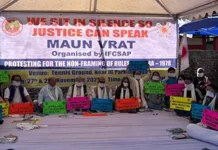Dr. Sopai Tawsik
Behavioural risk factors
Tobacco use
The prevalence of current tobacco use (smoked or smokeless) was 36.1%. The prevalence of smokeless tobacco use (24%) was higher than smoked tobacco use (19.1%).
Over a quarter (28.7%) of current tobacco users (smoked or smokeless) were daily users.
The mean age at initiation of use was 18.3 years.
The average duration of tobacco use among past smokers was 14.8 years.
Only 22.7 % of the smoked tobacco users had made self-attempts to quit smoking, while only 3.3% had been advised to quit tobacco use by doctor/health worker
Exposure to second hand smoke
Over half of the respondents (57.9%) reported exposure to second hand tobacco smoke in the past 30 days, either at home, during travel or at the work place.
Non tobacco betel products
As many as 12.6% of the respondents were current users of non-tobacco betel products in the form of pan masala, betel quid or areca nut. The use of arecanut (7.6%) was highest among current users.
Alcohol use
Over one third of the respondents (36.7%) had consumed alcohol over the past 12 months, while over a quarter (27.4%) had consumed alcohol over the past 30 days.
The mean age of initiation of alcohol use was 17.7 years.
Among those who consumed alcohol in the past 12 months, 9.6% were daily users and 3.5 % felt the need for a drink first thing in the morning every day.
11.5 % of the respondents engaged in heavy episodic drinking
Only 2.2% of the respondents had been advised to quit alcohol use by doctor/health worker
Diet
The average number of days of fruit intake was 1.5 per week
The average number of servings of fruits and vegetables was 2.3 per day.
Over 80 % of the respondents consumed preserved/salt curated and fermented products.
Over90% of surveyed adults reported to be having sufficient level of physical activity.
Raised blood pressure
Prevalence of raised blood pressure was reported to be 31.8% in males and 21.8% in females. It was found to be slightly higher in adults from rural than in urban region.
Over half of the respondents (55.8%) were pre-hypertensive.
Overweight/Obesity
According to WHO cut off values, 15.6% of the respondents were overweight, while 2.9 % were obese.
The prevalence of obesity was higher in males (3.1%) than females (2.6%).
Over half of the respondents had central obesity (52.5 %)
Raised blood glucose
The prevalence of raised fasting blood glucose was 2.2%.
Clustering of risk factors
Close to a fifth (19.6%) of respondents had a clustering of > 3 risk factors
Health seeking behaviour
As many as 43.4% of respondents had never had their blood pressure ever measured in life.
Among those with raised blood pressure, only 18.6% had their blood pressure under control.
Cancer screening
Only 5.6% of the respondents were aware of cancer screening for the three common cancers: Oral, breast and cervical cancer. Less than 1% had ever undergone screening for these cancers.
Health system response:
Less than 6% of the surveyed PHCs’ provided cancer screening services.
Less than a quarter of the PHCs’ had availability of counseling facilities for risk behavior through counselor or specialized personnel
A little over 10% of the Medical Officers positioned at the PHCs’ Proportion had been trained for NPCDCS/NHM (NCD related)/State program.
Over 80% of the PHCs’ reported to shortage of lab facilities for cancer detection.
None of the CHCs’ or District Hospitals provided cancer screening services.
Physicians were available only in a little over a quarter of the CHCs’. Gynaecologists were available in only about 50%of the CHCs’ and district hospitals.
Around 22.2% of the private secondary health facilities that were surveyed provided cancer screening, and close to half (44.4%) had cancer treatment facilities. However, only 11.1% of the facilities had supply equipment for VIA.
HPV vaccination was provided by 13.3% of the CHCs’ and 22.2% of the private health facilities
Recommendations
This report gives a detailed current health system scenario in Arunachal Pradesh. This survey conducted among the PBCR covered areas of Arunachal Pradesh helps re-iterate the need for cancer awareness and strengthen the health care system to provide its treatment. The recommendations hence can be described under the following topics:
Risk Reduction:
Risk factors like tobacco & alcohol use, physical inactivity, and unhealthy diet start as young as early adolescence. Measures for behavioural change and awareness creation become crucial in such stages. Efforts to provide information and awareness generation for the younger population and their caretakers should be implemented at educational institutions and workplaces. IEC & BCC provision among the teachers and faculty of the institution should be strengthened for implementing changes and guidance among the younger population.
Counseling providers should be made available in schools, colleges and hospitals to help in cessation programmes of tobacco & alcohol use and provide a healthy diet and lifestyle change guidance. Such provisions should also be strengthened among the HWC of sub-centres and PHCs for easier access.
Tobacco and Alcohol Cessation:
The prevalence of tobacco use is 36.1% in the state of Arunachal Pradesh, with 30% of the current tobacco users being consumers daily. The programmes that help in the cessation of tobacco & alcohol use should be catered at the level of PHC & CHC, which will cover comparatively a larger population. Given the mean age of initiation of tobacco use as 18.3 years in the state, more focus should be given to the reduction among early adolescent population and guide in follow up process.
Policy Implementation for Risk Factor Control:
Strengthening the existing healthcare policies like COTPA Act (2003) which promotes smoke-free indoor air, should be enforced at work places, leisure zones and educational institutions. The provision of alternative livelihood for those who practice indigenous methods of producing alcohol should be considered. This may help to reduce the availability of locally available alcohol products.
The government of Arunachal Pradesh must take an appropriate policy decision to contain the tobacco sale and use in the state. COPTA Act (2003) must be implemented in letter and spirit.
Similarly, there must be some policy for curbing excessive alcoholism affecting the population of the state especially, the younger population.
Early detection and Screening:
Conducting periodic surveillance of behavioural and metabolic risk factors to measure the baseline prevalence and monitor changing trends through regular surveys would help track the impact of preventive measures. To enforce screening practices among a larger population, the regional & community leaders, along with the help of peripheral healthcare workers can be used. Practicing village/urban nutrition day and sanitation day will help achieve community participation. Through such measures, social and cultural acceptance of health practices can be achieved.
Health System Strengthening:
Expanding the availability of cancer care services with consideration of access in such geographical terrains should be prioritized. Also, it facilitates the adoption of health technology for the prevention and treatment of cancer, including digital tools for early detection and telemedicine for improved access to care in the healthcare system.
Strengthening the medical certification of cause of death for the availability of accurate and complete cancer mortality should be given utmost importance. As there is a shortage of healthcare workers, increasing the capacity building of healthcare providers through regular training, re-training and skill enhancement should be done. Also, expanding and strengthening the services at secondary and tertiary level health facilities would help reduce treatment-seeking for cancer outside of the region. The government ought to consider having proper secondary level facilities in all the districts of the state so that people are not denied proper health care access considering the topography and terrain of the state.
Cancer Registries of the state, which generate good data on cancer incidence, survival, and mortality in the state, need to be supported by the government. Given the high incidence of cancer cases, the state should have at least two full-fledged cancer hospitals. Facilities for early detection and diagnosis of cancer should be available in all secondary and tertiary health facilities.
As described in detail above, addressing cancer control requires a multidisciplinary approach with community participation.
As the data proves, cancer does not appear to be a stigma; therefore, interventions to enhance the health-seeking behaviour related to screening and early detection should be implemented with rigour. This involves measures to strengthen prevention to palliation to provide the continuum of care required in this need of the hour.
(Dr. Tawsik is the DME and Principal Investigator, West Arunachal Population Based Cancer Registry, Tomo Riba Institute of Health and Medical Sciences, Naharlagun)


